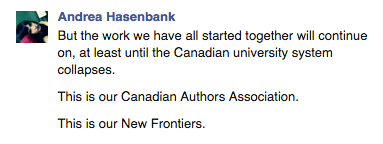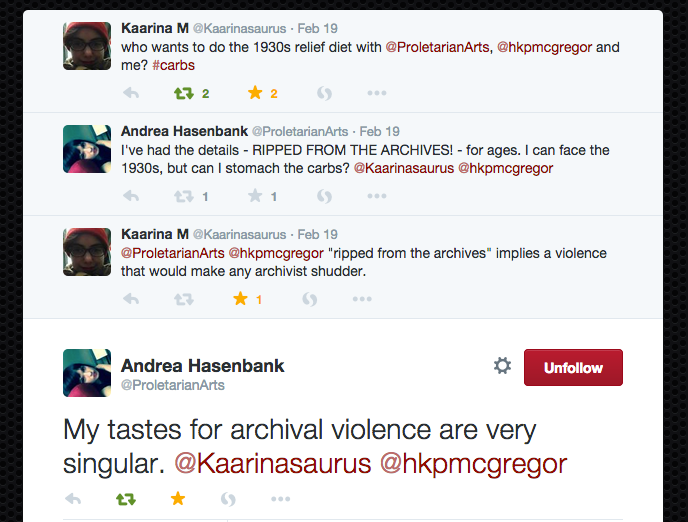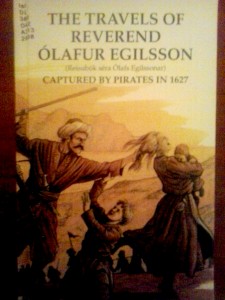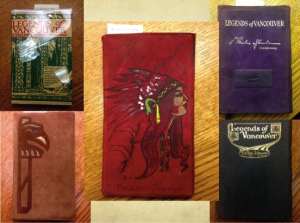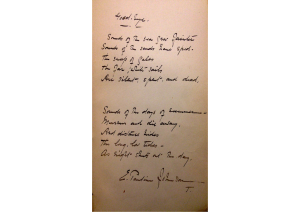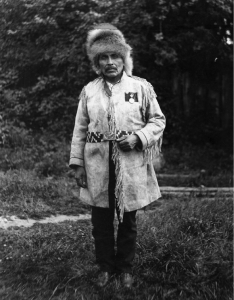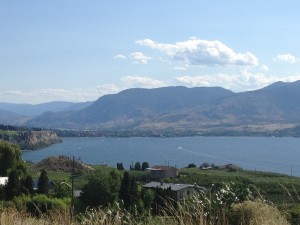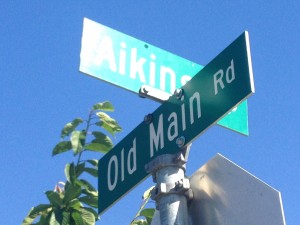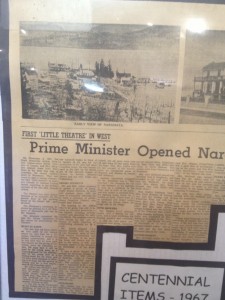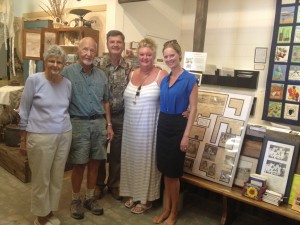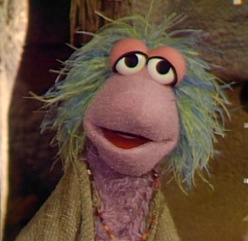Archives
Archive for the ‘Research’ Category
April 28, 2015
A Portrait of the CMMP as a Young Project
I’ve been asked to briefly reflect on my work as the Principal Investigator for the EMiC PhD Stipend-funded Canadian Modernist Magazines Project (CMMP). Before outlining a few of my activities over the past year, though, I’d like to echo recent posts—by Kaarina Mikalson, Hannah McGregor, Carl Watts, and Alix Shield, among others—in thanking EMiC for facilitating so many exciting projects and productive, energizing, and fun conversations. EMiC has changed the way I think about academic communities, collaboration, and my own field(s) of research.
My goal with the CMMP has always been pretty straightforward: digitize full runs of Preview (1942-44) and First Statement (1942-45) so that they can be read and analyzed online. But there is more than one way to skin a cat (apparently), and, as I’ve learned, there is certainly more than one way to digitize a text (none of which involve violence against animals, unless we’re talking vellum). This is an obvious point to make, perhaps; I mention it only because this reality—that there is no single way to scan, transcribe, and display texts online—has been both incredibly overwhelming and incredibly liberating as I think about the crucial next steps for the project. I want to save time and money by adapting the best practices and workflows of similar digitization projects, but I also want to find ways to set the CMMP apart, making it as user-friendly and powerful a resource as possible. How does one follow in others’ (giant) footsteps and still leave a mark?
So far, much of my work has involved laying important groundwork that, in the end, will be invisible to end-users of the CMMP website. For example, I have spent many hours researching the best ways to record, host, and display metadata, and many more communicating with various scholars, librarians, and institutions. My biggest job, however, has been tracking down contributors’ surviving family members or literary executors, a process which has been surprisingly difficult. Even so, the challenge of securing permissions has also been a rewarding one: one of the great perks of this project has been learning more about all of the magazines’ contributors as human beings, not just as names attached to poems or essays. In the course of my slow, sometimes fruitless detective work, I have unearthed many fascinating stories about who these writers were and what kinds of amazing things they did with their lives. The 60 or so contributors to First Statement and Preview went on to become poets, professors, Members of the Order of the British Empire, Members of the Order of Canada, founders of some of Canada’s most prestigious literary journals, actors, lawyers, psychologists, and proud parents. Some are still familiar names in the Canadian literary community, but many are not.
Although it’s still unclear when I will be able to launch the CMMP, I feel good about the progress that’s been made, and I’ve already been thinking ahead to the future of the project for some time. As far as I’m concerned, the CMMP’s digitization of Preview and First Statement is only a starting point: in fact, I’ve already begun to eye up other magazines worthy of digitization and to consider how I can keep the project alive and well through new partnerships or funding opportunities. In any case, I’ve received enough encouragement—from fellow EMiC-ites, from colleagues, and from patient friends—to believe that my optimism about the potential value of the project has not been ill-founded. Indeed, one highlight from this past year was talking about the CMMP with other modernists at the Modernist Studies Association’s annual conference in Pittsburgh. While running a digital exhibit with Dean Irvine on the CMMP and the Modernist Commons, I was fortunate enough to meet Sean Latham, Jeff Drouin, Cliff Wulfman, and Kent Emerson of the Modernist Journals Project (MJP), and their positive feedback about my own still-nascent project was tremendously encouraging. Since then, I have received further advice and encouragement from the MJP’s Kent Emerson and Mark Gaipa, not to mention the invaluable advice of my lovely EMiC friends (and, on that note, I’d be delighted to hear from anyone who would like to be involved in the project in any way).
I’m not sure what the CMMP will look like in another year, but I remain excited about its possible futures—and grateful to EMiC and the EMiC community for making my project possible in the first place.
April 16, 2015
Productive Failure
I have been asked to reflect on my experiences as an EMiC funded RA. This post looks at my ongoing involvement with the critical edition of Dorothy Livesay’s Right Hand Left Hand. In my previous post, I thought through my work with Canada and the Spanish Civil War (CSCW).
In a panel last April called “What the eFs!?!: Why Our Research Matters Now,” Hannah McGregor talked about how digital humanities work taught her how to fail. If I recall correctly, she described the necessity of failing in digital work: errors in code can crash a website, or you can spend an afternoon trying to perfect a PHP script that still refuses to function, but at the end of the day its alright. You will start again tomorrow, with more help and new ideas, and move a little closer to success. In contrast, failure in the humanities is terrifying. I don’t want to write about what failure looks like in the humanities–it is the stuff of anxious dreams, and that is where it should stay.
What is essential about failing in digital humanities is the trying: each time you try something, you learn a little more about what doesn’t work, and inch closer to what does. When I began working as a research assistant for the critical edition of Dorothy Livesay’s Right Hand Left Hand, I experienced this failure with a great deal of frustration. A new scanner meant I had to rescan Livesay’s work. Errors in file naming meant a great deal of manual renaming, or wrestling with unreliable file naming programs. OCR readers, in all their imperfect glory, required me to carefully reread and correct text. And through it all, programs crashed, mistakes were made, equipment and files were (quite literally) stolen, and I did it all over it again. Every time I failed, I became more vigilant, until I was checking and rechecking obsessively.
As frustrating as this was, it was productive failure. By the time I advanced from RA to co-editor, I knew the material from every angle. I had read Livesay’s words again and again–I knew them so well that as I wrote my own thesis on literature of the Great Depression, I felt compelled to cite Livesay constantly, as all my research echoed her memories, poetry, and journalism. As I moved onto new DH projects, I was constantly surprised at how much all those failures had taught me about working carefully and effectively, about data management, and about digital research tools. All that failed work that had felt wasteful paid off in the long-term–at least for me, and I hope for the projects as well.
Now that I work mostly on Canada and the Spanish Civil War, I am confronted with another kind of failure: the failure of the international movement against fascism. It seems to me that this failure reverberates in the lives and work of so many Canadian modernist authors. I don’t have much to say on this yet. I know that addressing this particular failure has been the most challenging part of my thesis work. I know that failure will continue to be a challenge in every aspect of my life. But it is heartening to know that, in its own small way, DH work makes failure more familiar and less devastating.
Three years after I began my RAship, the Right Hand Left Hand text is almost ready for submission. When I look at the single document that lives in my dropbox, I think of all the documents, folders, spreadsheets, bibliographies, and files that brought this edition to life, and of all the work that was undone and redone to bring this single text to life. And, of course, building on my last post, I think of the team of people that made it happen: Bart Vautour, Dean Irvine, Emily Ballantyne, Leslie Gallagher, Karen Smith at Dalhousie Special Collections, the staff at the University of Manitoba Archives, and many others. Ultimately, their knowledge and support made this project a successful one.
April 14, 2015
Thinking Through Ethical Collaboration
I have been asked to reflect on my experiences as an EMiC funded RA. In this post, I think through my work with Canada and the Spanish Civil War (CSCW). My next post will look at my ongoing involvement with the critical edition of Dorothy Livesay’s Right Hand Left Hand. A big thank you to Emily Ballantyne for providing feedback on this piece.
By the time I joined CSCW, I had already worked for EMiC for a couple of years. I came into EMiC when it was already well underway. In many ways, I felt I could never really catch up; there were so many acronyms to learn, so many scholars to meet, and such a range of digital and literary projects that I only ever glimpsed. I learned many technical skills, but never enough to keep pace with this rapidly evolving and expanding project. I was impressed, excited, and ultimately (necessarily) overwhelmed.
But for me, the real beauty of EMiC is that it facilitated so many smaller projects. I got involved in Canada and the Spanish Civil War fairly early, and I witnessed its development. Emily Robins Sharpe and Bart Vautour study social justice movements, and they ensure that social justice is the foundation of their project. I am grateful to see the inner workings of the project, to see how policies and communities take shape around certain collective values. There is a great deal of emphasis in the digital humanities on skill development, and for a while I focused on developing my technical skill set. Through CSCW, I saw how deliberately I needed to develop interpersonal skills. It takes a great deal of space and energy to practice effective communication, transparency, collaboration and respect. I am grateful to have all of these modelled for me through this project.
In my own research, I ask what productive collective action looks like in Canadian fiction from the Great Depression. One chapter of my thesis looks at the Canadian Spanish Civil War novel This Time a Better Earth, and the different forms of antifascist work that it portrays. This project has asked a lot of challenging questions about what labour looks like, how we value different forms of labour, how women and people of colour become sidelined or exploited in collective work, why this happens, and how to model more sustainable and equitable movements. It is fairly easy to apply these critiques to literature of the 1930s, but much harder to critique and remake the projects, movements and institutions that I am a part of. This is time-consuming work, and it can be daunting. I am a privileged individual completing my second, well-funded degree in an increasingly neoliberal university system; I am already complicit in and benefiting from a broken system. But when I scale down, to the small-but–growing projects and communities I get to be a part of, I start to feel more hopeful and more prepared.
One of the reasons I am writing about the interpersonal outcomes of my RA work and not the digital outcomes is because all of that digital and editorial work feels incomplete, though I recognize the necessity of sharing ongoing work. But ultimately, I feel like those tangible things – the Canada and the Spanish Civil War website, the growing bibliography of Canadian writing on Spain, the forthcoming (and already underway) book series, even my own thesis – are not mine to claim. They are inherently collaborative, and as such their success hinges on healthy community. In an earlier EMiC post, Andrea Hasenbank wrote: “The work I have detailed here is one throughline of the work always being done by many, many people. You do not work alone, you should not work alone, and if you are not acknowledging those who work with you, your scholarship is unsustainable and unethical.” This, to me, is the real unfinished work that is giving me pause. How do I ensure that my work is always in line with my values? How do I respect my collaborators, academic and otherwise, my research subjects, my supporters, and my audience? I am grateful to EMiC and Canada and the Spanish Civil War for giving me the opportunity to apply these questions. In her farewell to EMiC, Hannah McGregor wrote, “communities preserve and support us; they give us perspective on what really matters, back us in our struggles, keep us sane and human in the face of systems that threaten to break us down.” Looking forward, I am confident in the excellent communities EMiC has produced, and in the productive and supportive thinking that it has fostered in so many of us.
March 31, 2015
Community and Precarity
“Also, happy last day of EMiC.”
This message just appeared on a Facebook chat I’m having with three other EMiCites, as we discuss exactly how much social time we can fit into the upcoming Digital Diversity conference in Edmonton. Many of us are not attending DHSI this year — our normal summer meet-up spot — and so we’re treating DigDiv as a mini reunion.
It’s not really the last day of EMiC. A simple fiscal end-date will not spell the end of the projects and collaborations we began over the past seven years, many of which will continue in various forms and reverberate through our institutions and disciplines.
I have benefitted from tremendous research and training opportunities through my affiliation with EMiC. Since the first day that co-applicant Paul Hjartarson invited me, an utterly overwhelmed new MA student, for a coffee in HUB mall at the U of A and asked if I’d be interested in joining a project that would send me to Victoria to learn something about computers, EMiC has shaped my academic trajectory. The connections I made in that first year led directly to my current position as a SSHRC-funded postdoctoral fellow, back at the U of A and working with Paul again, now with five DHSIs under my belt and a somewhat more robust sense of what computers do. I am hugely grateful for having been in the right place at the right time.
But what I will value, more than the conferences and seminars and publications, is the community.
It will be news to absolutely no one that it’s a scary time to be an emerging academic right now. The discourse is positively apocalyptic. Many of us are leaving academia altogether, seeking out rewarding careers in different fields. Others hold on, trying to stay committed to the values of our teaching and research while experiencing the real costs of our precarity. I don’t use the word precarity lightly — we should never forget that our “shared precariouness” is not shared equally — but I use it here to underline how powerful communities can be in the face of this affective burden.
Professional opportunities can help to pave the way to exciting careers. Interdisciplinary and multi-institutional collaborations produce innovation and new knowledge. But communities preserve and support us; they give us perspective on what really matters, back us in our struggles, keep us sane and human in the face of systems that threaten to break us down.
I often talk about the collaborations that make my work possible, but I rarely talk about the communities that make it possible for me to do my work. As important as the days spent in DHSI courses, struggling with TEI and databases, were the nights at karaoke bars, bonding over nostalgic 90s alt-rock. And while I can’t say where my career will take me in the next five or ten or twenty years, I take comfort in knowing that I’ll always have a bunch of nerds to make #canlit jokes with me.
March 31, 2015
The Dove and the DH Guru of Indiana: The Carl Watts Story
It’s hard to believe that it’s been almost a year since I was given the go-ahead to begin my digital edition of Laura Goodman Salverson’s The Dove. When I got this opportunity, I knew very little about the Digital Humanities. It often feels like this is still the case; nevertheless, in the past year I’ve attained some practical skills, made some new CanLit discoveries, and embarked on a mission to help people who also feel incompetent as they take their first steps in the world of DH.
Although I had for some time been thinking about the relevance (or at least peculiarity) of The Dove, last spring I was suddenly overwhelmed with practical questions that needed answering. Scanning pages was easy enough, but some other basic steps were bound up with a slew of large and poorly formed queries: Is this the Tesseract I’ve heard about? How do I make it work? Can a lone man indeed create a digital edition on his laptop? Where does it go? During those early days in Kingston it seemed like there was nowhere to turn.
With the help of two fabulous colleagues (Google and Emily Murphy), however, I was eventually able to crack the code. The first colleague taught me how to generate reams of .txt files in which each gross stain on the pages of the novel was transcribed as a * or a Q. The second colleague solved my schema problem and pointed out some errors I had made in my TEI markup. This eleventh-hour save notwithstanding, I would describe myself as a master of DIY TEI. And while my basic TEI/XML markup is functional, my CSS skills are currently both DIY and LOL.
As I’ve been messing around with CSS, I’ve also continued researching the text’s history. I’ve always felt strange using the word “research” to describe my academic work; all this word ever really meant to me (as a graduate student) was frantically reading articles and then synthesizing them into either a term paper or an attempted publication. In contrast, having an entire funded year to read around a topic allowed me to make some actual discoveries. For instance, on my trip to view the typescript of the novel at Library and Archives Canada, I learned that Salverson made corrections with a green pen and that government employees enjoy eating lunch in food courts. As far as The Dove is concerned, I managed to uncover a consistent error in the small amount of writing that has mentioned the novel. These sources usually describe the text as based on an Icelandic saga, but my readings in this area revealed that this word usually refers to other, much earlier sources. Meanwhile, Salverson seems to have based her novel on one particular, somewhat different text: a seventeenth-century memoir entitled The Travels of Reverend Ólafur Egilsson. Much of the background research that led to this discovery has found its way into my introduction to the edition. This introduction is only about half finished, but when I mutter things to myself I definitely describe it as “masterful.” In the meantime, I’ll leave you with a picture of the memoir, which was conveniently translated into English for the first time in 2008:
I’m also fresh off delivering a grotesque Frankenstein’s Monster of a conference presentation at the annual meeting of the College English Association in Indianapolis. I started by describing my edition and discoveries, moved on to some practical tips regarding getting a digital-editing project off the ground, and concluded with a state-of-the-discipline rumination on textual communities and critical contexts in our early- or mid-DH epoch. Some audience members looked bewildered (in one case, disgusted), but when the session ended I was greeted by a lineup of people who either had technical questions of their own or were offering their thanks for being provided with a basic plan for getting started on a similar project. After having spent my early days struggling to answer such basic questions, I felt good knowing that I was now able to help people in similar situations. Perhaps some of the horrified looks I got during the presentation were merely reactions to the Religious Freedom Restoration Act, which was passed just as I arrived in the city. On that note, I took this picture of the Indiana Death Star shortly after I dubbed myself the DH Guru of the state:
As I move on to the next stages of the project, I want to thank Glenn Willmott, Emily Murphy, and Google for their advice. Also, obviously, a big thank you goes out to Dean and EMiC for allowing me to make progress on the edition and encouraging me to share my research and experiences.
March 27, 2015
Legends of Vancouver: Collaborative Learning (and Putting Ethics into Practice)
Greetings, EMiC community!
At nearly two semesters into my PhD at Simon Fraser University, I have some exciting research updates to share. For the 2014-15 year, my EMiC PhD Stipend project proposed to analyze and digitize E. Pauline Johnson and Chief Capilano’s Legends of Vancouver (first published in 1911).
My stipend project began with many, many hours spent in SFU’s Special Collections library. With more than 50 copies of Legends in its holdings, SFU boasts an impressive collection that spans over a century of publication.
One of the most interesting parts of my research thus far has been investigating unique inscriptions and markings found in earlier copies; these paratextual elements situate Legends as a site for both remembrance and memorialization. In earlier editions of the text (those published between 1911 and 1913, while Johnson was still alive), some copies contain additional inscriptions penned by Johnson herself. In one case, Johnson makes the poignant exchange of the poem “Goodbye” as compensatory for the book’s shoddy construction: “this book seems to be rather badly put together so – I have written out a poem on the back flyleaf to ‘even things up’ – EPJ”.
In this poem, Johnson alludes to the passage from day into night as a metaphor for the transition from life into death. Her decision to inscribe this poem in 1912, only months before her eventual death from breast cancer, is curious. The poem is also significant in regards to the idea of loss – particularly as an expression of cultural mourning.
While comparing and analyzing the variant copies of Legends, I became interested in the changing paratextual apparatus and the ways in which it evinces an ongoing political and ideological series of recoveries and losses – specifically relating to Chief Capilano. Since this text was produced during the height of the socio-political movement of salvage ethnography (whereby Indigenous peoples were deemed to be on the brink of extinction), traces of these colonial power relations are present in the book’s paratext. With this anthropological trend, imbalanced power relations prevailed, often privileging the non-Indigenous voice and overshadowing the contributions of Indigenous collaborators. Early editions of this book speak to this imbalance in power, beginning with the front cover – while the generalized image of a male Chief (adorned with what appears to be Plains Indian regalia) is depicted, only Johnson’s name is listed as author. There is no mention of her collaborator on the title page, nor in the “Biographical Notice” section – and this process of erasure was perpetuated with subsequent editions. More contemporary versions of this text now include additional material about Johnson, but Capilano’s presence is still comparatively scarce (and to date, I have not seen a single edition of Legends that includes his photograph).
These observations bring me to my current research question: Why, in regards to this text, has Chief Capilano not been given the same kind of recognition as Pauline Johnson?
I am currently working in collaboration with members of the Coast Salish community to learn more about their perspectives on the Legends text. My hope is that by encouraging community dialogue and involving the descendants of Chief Capilano in this process, I can do my part to balance out the historical record. While this shift in focus strays from my initial goal of producing a digital edition, I believe that involving the community in this conversation first is necessary. After all, these are their stories.
Recently, I’ve had the opportunity to take part in an interdisciplinary colloquium and speaker series at SFU titled “Protecting Indigenous Cultural Heritage: Emergent Policy and Practice”. This series focuses on presenting new approaches to collaborative research and Indigenous policy development. As a non-Indigenous scholar working in the field of First Nations studies, this series has provided me with immeasurable insight as to best protocols for ensuring respectful collaboration. Most importantly, I’ve learned the value and necessity of putting ethics into practice. This means that my research may take more time – but I’ll be satisfied knowing that my research practices align with and reflect contemporary values regarding the protection of tangible and intangible Indigenous cultural heritage.
I would like to thank EMiC, and Dean, for giving me the opportunity to pursue this research.
March 24, 2015
Modernism Will Truly Never be the Same
By Glenn Willmott
As spring approaches, and eight years of EMiC’s flourishing, I think it’s reasonable to wonder if EMiC has not been the most widely and deeply productive collaborative literary project in Canada. No doubt, really. But there’s one thing that must stand out above all: the truly extraordinary devotion, creativity, and love of literature in the generations of present and past students who have made EMiC what it is. I am immensely appreciative of Dean, for having started it all, and kept it going, and to all those senior scholars who played their parts in research projects large and small. But to all those who are or have been student members of EMiC, I want to express my gratitude and admiration. Modernism will truly never be the same. In the right sense 
March 18, 2015
A Journey to Naramata: Uncovering the work of Carroll Aikins and Canada’s “First” National Theatre
Given that I am barricaded at home during yet another snow day in Nova Scotia, I feel it is only fitting to write a blog post on summer productivity as some sort of ode to warmer weather. This summer, after an enriching week with Karis Shearer at UBC Okanagan’s TEMiC, I drove to Naramata as a pilgrimage to the location of Carroll Aikins’s Home Theatre—a theatre built above a fruit packing and storage facility in 1920 that was devoted to training Canadian actors.
I have been researching Aikins in large part because of the uniqueness of his play The God of Gods, which premiered in Birmingham, England in 1919 to the praise of theatre critics. The God of Gods seems to be the little play that could: it enjoyed a second mounting at Birmingham Repertory Theatre in 1921, came to Toronto’s Hart House Theatre for their 1922-23 season, then was produced in London, England in 1931. The play’s success abroad is by no means its only notable element; it is also a modernist play that engages in primitivism, anti-war sentiments, Nietzschean philosophy, and theosophy. And while Aikins is little know in today’s theatre circles, this seems to be far from true for many of the people in Naramata (even if the street signs offer variant spellings of his name).
Naramata’s Heritage Museum welcomed me with open arms; the elders regaled me with stories of the Aikins family, shared relevant local histories, and offered valuable resources (books, photographs, contact information for surviving Aikins family members). Craig Henderson, in particular, was incredibly helpful and acted as a tour guide, taking me to Aikins’s old home, Aikins’s Loop (where the building that housed the Home theatre can be found), and the remains of the Home Theatre. I have kept in touch with Henderson and he is hoping to produce one of Aikins’s other plays in the near future—a potential venture that nicely integrates my experience at TEMiC and DEMiC with my work on Aikins because a recording of a production of one of Aikins’s plays would make for an excellent online teaching or research tool.
Interviews with local historians and theatre practitioners helped to explain many of the allusions to historical figures and local folklore in Aikins’s plays. This trip solidified the value and necessity of qualitative research for my field—theatre, after all, occurs off the page and it is only in meeting with artists and visiting the homeland of Aikins and his Home Theatre that The God of Gods becomes a living piece of art.
(By Kailin Wright)
November 13, 2014
“everythings too fuckd up today” & the revolution cannot wait: a brief reflection on the political at Avant-Canada
Not all delegates of the Avant-Canada conference would necessarily locate themselves under the umbrella term avant-garde since it is, as many critics have pointed out, a contentious, perhaps even outmoded, label with controversial militaristic connotations. However, I find the term useful in articulating a position that is not compliant with the status quo. More pointedly, the term, for me, identifies a radical mode of praxis that seeks fundamental social or political change. Avant-Canada was a meeting place for many of these types of poets, artists, and thinkers.
Continental theorists of the avant-garde such as Renato Poggioli and Matei Calinescu have addressed (with varying degrees of complexity and success) what are generally considered to be the two vectors of the historical avant-garde: 1) the radical political avant-garde, art in the service of social and political ideology; and 2) the aesthetic avant-garde, the belief that liberating artistic and literary form possesses the power to change society. This binary is over-simplified and specious, but it was while I was en-route to Avant-Canada that I wondered which face of the literary and artistic avant-garde I would enjoy over the course of the three-day gathering. Of course, it would be egregious to suggest that the conference reflected any one variant––numerous perspectives on the role of politics in art were situated, from the politically charged lyrics of the dub poets Lillian Allen, d.bi young, and Chet Singh to the more insidious formal experiments of conceptual writers like derek beaulieu and Christian Bök. From my perspective, however, the conference was characterized by a concern for topics of a more radical political interest over aesthetics.
The discussion I was privy to oscillated around topics of injustice, misogyny, and exploitation, among other issues. I am thinking of the timely “killjoy” panel “The Female Future-Garde in Canada” during which the panelists addressed issues of feminism, academia, and community by sharing not only their critical assessments, but their deeply personal narratives of experienced sexism, misogyny, and assault. The discussion was triggering and effectively confrontational––these panelists (whom I deeply admire) recognize, as Lee Maracle does in her essay “Ramparts Hanging in the Air,” that, “Silence is no longer a weapon of resistance.” Instead they vocalize a rightful opposition to the egregious offenses they face as they work to re-shape discourse, develop tactics of resistance, and strategize for the future. The roundtable left me exhausted and, as Julia Polyck-O’Neil has also indicated in her post, feeling “heavy,” but that heaviness, that weight, is something I want to carry with me as I continue to research, write, and organize to remind myself of the ways in which I can and should contribute. And I am also thinking of the dub poets, the cacophony of Jordan Abel’s plundering of Western novels in his performance of Un/Inhabited, the lucid anger of Lee Maracle’s keynote on colonialism and memory as a site of activism, Michael Nardone’s analysis of the sonic/spatial disruptions of the Idle No More Round Dance, and Skawennati’s futurist mini-series TimeTraveller™. Amongst these proceedings was my own presentation – ‘the killing of speech:’ The Sonic-Politics of The Four Horsemen” – which sought to develop a theoretical context that recovers the material and political possibilities of the sound poetry event that some sound poet practitioners have long abandoned.
The political spirit of these happenings is timely amid Canada’s ongoing climate of socio-political tumult, and indicative of a restlessness, discontent, and desire for change. It was a moment of not only broadening political and aesthetic consciousness, but the formation of a network committed to change. While bill bissett, in an apparent moment of disillusionment in 1978, once wrote “th revolushun will have to start tomorrow / everythings too fuckd up today,” Avant-Canada was a crucial interstice that saw the productive collusion of artists, activists, writers, and thinkers unwilling to wait.
November 12, 2014
Get Moving!: The Avant Canada Conference
by Kailin Wright
The Avant Canada conference (organized by Gregory Betts) fueled discussion and debates over the future—the future of Canadian art, scholarship, politics, and the academy. It was a conference that brought together scholars and artists; a conference that examined the avant garde of the pasts and futures; a conference that took me from panels on political futurity in Canadian literature, to video games, to representations of Aboriginal culture in the digital humanities, to small presses with Stan Bevington, to bp Nichol and Fraggle Rock. Personal touches like a boxed edition of Avant Canada: more useful knowledge (edited by Derek Beaulieu and Gregory Betts) and an encouraging email from Gregory Betts to the first panelists on Wednesday morning stood out, especially considering the sheer number of attendees and the scope of the conference.
I delivered a paper on failed pregnancy as a symbol of a failed national future in Canadian drama and participated in a roundtable discussion on EMiC emerging scholars. On Wednesday, I was fortunate to be a part of the “Future of Work” panel that included EMiC graduate fellow Julia Polyk-O’Neill, Robert David Stacey (Ottawa), and Carmen Derkson (Calgary); we received provocative questions on the performance of female howls as an embodied language in its own right and continued our discussion of the distinctions of gendered labor versus work late into the night
.
On Thursday, the EMiC Emerging Scholars Roundtable offered a look back at the past 7 years of the project—with all of its publications, mentorships, and training opportunities—as well as a look forward with the uncertainty of the market. Chaired by the EMiC Director Dean Irvine, my fellow roundtable discussants included Karis Shearer (UBC Okanagan), Bart Vautour (Dalhousie), and Marc André Fortin (Sherbrooke). In short, a group of scholars who I continue to learn from as they discussed Canadian poetry recordings (Karis), the Spanish Civil War project (Bart), and a daring blank edition of Barbieau’s The Downfall of Temlaham (Fortin) that performs issues of appropriation.
The conference culminated late Thursday afternoon in the spontaneous coming together of two distinct panels: one made up scholars discussing Digital First Nations and one with artists of the Dub poetry revolution. Jason Edward Lewis (Concordia), Michael Nardone (Concordia), and Stephen Foster (UBC-Okanagan) delivered work on Aboriginal territories in cyberspace, the phonopoetics of the Idle No More Round Dance Interventions, and contemporary representations of Indigenous peoples in popular culture, respectively. These papers were interlaced with performances and talks by Lillian Allen (OCAD), Chet Singh (Centennial), and D’bi Young (Independent Poet) on the political and personal in poetry. The last performer-speaker was D’bi.Young who ended the panel by performing a piece about the political shaming of female blood—a performance that took her into the audience because of, as she later explained over dinner, the sheer energy of the viewers.
This was a conference that brought you out of your seat and onto your active, political feet as you danced with artists, thinkers, readers, and activists to the sounds of Fraggle Rock.
